Double Beam Balance Principle
- The Double Beam Balance (mechanical balance) is intended for laboratory and classroom use. Based on the basic Roberval balance principle, the Double Beam Balance permits the determination of the mass differential (rather than the absolute value) between two objects. These balances are supplied with sliding masses.
- Double Beam Scales are renowned for their precision and longevity. With a two-pan construction based on the classic Roberval balance concept, Double Beam Balances include magnetic damping, beams with sliding weights, and an assortment of weighing platforms.
- The precision weighing devices of the Double Beam Balance series are designed to give years of service with minimal upkeep. With a single unit of measurement and application method.
- Angled beams and pointers are simple to read and aid in the reduction of operator errors. Highly versatile and robust.
- Special counter-balancing knob with a floating agate bearing enables rapid zeroing and maintains its position.
Purpose of Double Beam Balance
- To determine the mass of any powders or compounds in the laboratory.
Operating Procedure of double beam balance
- Ensure that no object or weight is placed on the balance, and set the weights on the beam scale to zero. Check to see if the needle on the balance points to zero.

- Place the object to be measured in the left pan and adjust the beam-weight strips to the right until the needle reads zero. (Be patient because it will take some time.) The bottom beam can add up to 200 grammes in increments of 10 grammes. The upper can add up to 10 grammes in increments of 1 gramme.

- Calculate the total weight based on the grammes displayed on the scale. This is the object’s mass in grammes.
- If the mass of an object exceeds 210 grammes, additional masses must be placed on the right side pan. The total mass is the sum of all the weights added together.

Advantages
- A double-pan balance makes it easy to compare the weights of two different things right away. Each pan has an object in it. The pan with the heavier object will fall, while the pan with the lighter object will rise. This will show which thing is heavier, but it won’t tell you how much each thing weighs.
- No electricity to operate.
- Easy to handle.
- Give accurate measurement.
- Long lasting.
- Low maintenance cost compared to digital balance.
Limitation
- The accuracy of a double-pan balance is only as good as the smallest weight used to balance it. If you only have 5-gram weights, you can only guess the target object’s weight to the nearest 5 grammes.
Usage of Double beam balance
- The thing that needs to be weighed goes on 1 pan. The other pan is slowly filled with small weights until the scale reads “0,” which means it is in balance. When the weights are added up, the target object’s weight is found.
- You can also use a double-pan balance to figure out how much of a substance is needed to make up a certain weight. For example, if you wanted to measure 10 grammes of sand, you could put a 10-gram weight in one pan and fill the other pan with sand until the scales were balanced.
Difference Between a Triple Beam Balance & Double Beam Balance
- A triple beam balance is an instrument that can weigh things. It gets its name from the three beams that hold the weights: one that reads in 100-gram increments, one that reads in 10-gram increments, and one that reads from 0 to 10 grammes and can be broken down even further into tenths of a gramme. A double beam balance, also called a double pan balance, is a scale that works like a seesaw. It gets its name from the two pans or balances on either side of a fulcrum.
- The triple beam is the best way to figure out how much something weighs. If you just want to figure out which of two things is heavier, the double beam is the way to go. In the same way, you can use the double beam if you know how much something weighs and want to find out how much of something else it takes to equal the weight of the first thing. For example, if you have a 30-gram weight and want to know how much sand that equals, put a 20-gram weight and a 10-gram weight on one pan, then put sand on the other pan until both pans are balanced.